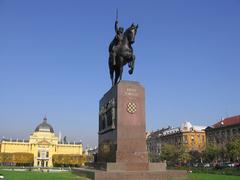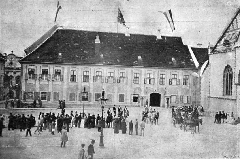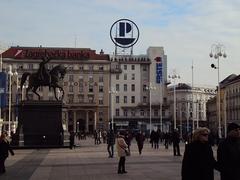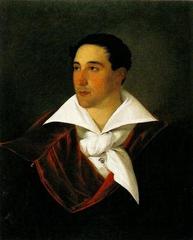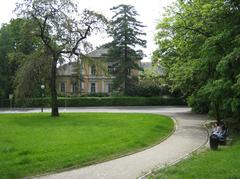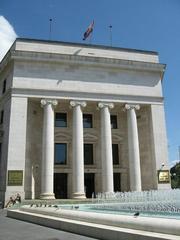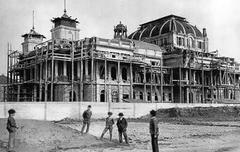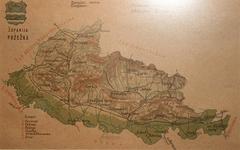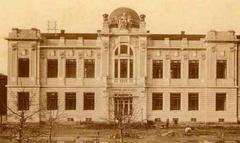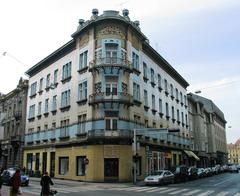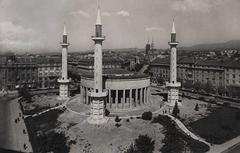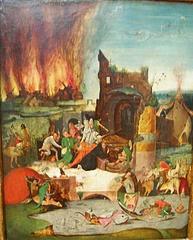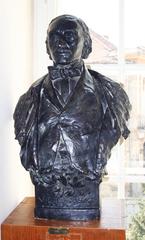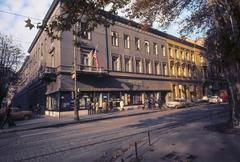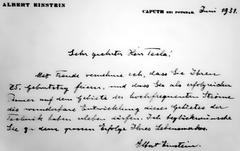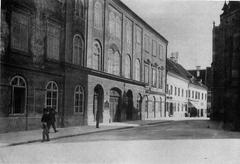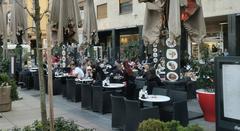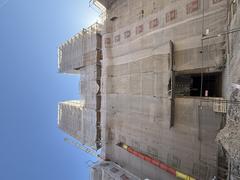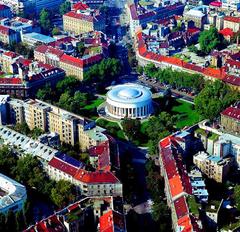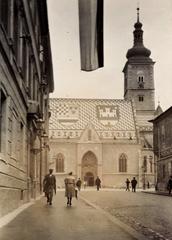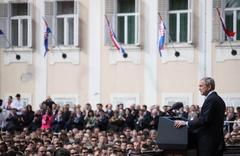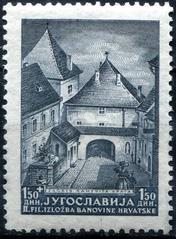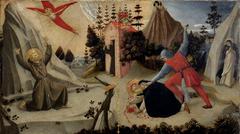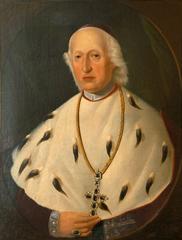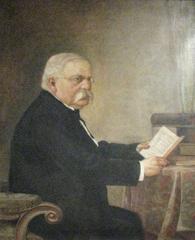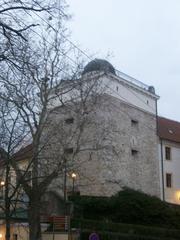Dverce Palace Zagreb: Visiting Hours, Tickets, and Travel Guide
Date: 14/06/2025
Introduction: Historical Significance and Visitor Overview
Dverce Palace, situated in Zagreb’s storied Upper Town (Gornji Grad), epitomizes the city’s aristocratic heritage and vibrant civic life. A masterpiece blending Baroque origins with 19th-century historicist renovations, Dverce Palace serves today as a ceremonial venue for official events and cultural festivities. Although not open for regular public tours, the palace allows access during special open days, festivals, and guided tours, offering rare glimpses into its rich past and architectural grandeur. Its position on Katarinin trg places visitors steps away from iconic landmarks like St. Mark’s Church, Lotrščak Tower, and the Stone Gate, anchoring it at the heart of Zagreb’s historical and civic center.
The palace’s story begins in the mid-18th century and is marked by significant 19th-century transformations under Austro-Hungarian influence. Originally a noble residence, Dverce Palace was bequeathed to the city in the early 20th century, evolving into a hub for public ceremonies and cultural events. Today, it remains a focal point for those wishing to explore Zagreb’s layered history and architectural traditions.
This comprehensive guide details how to visit Dverce Palace, including current access options, ticketing, notable architectural and cultural highlights, and practical travel tips. For up-to-date event and visiting information, check resources like the Zagreb Tourist Board and the City of Zagreb’s official website. The Audiala app also offers curated guides and audio tours to enrich your exploration (source, source).
Contents
- Discover Dverce Palace: Zagreb’s Upper Town Gem
- Visiting Dverce Palace: Hours, Tickets, Access, and Guided Tours
- Getting to Dverce Palace
- Historical and Architectural Overview
- Cultural Significance and Artistic Features
- Accessibility, Visitor Tips, and Etiquette
- Nearby Attractions and Amenities
- Frequently Asked Questions (FAQs)
- Visuals and Media Highlights
- Plan Your Visit: Resources and Further Reading
- Summary and Final Tips
Discover Dverce Palace: Zagreb’s Upper Town Gem
Dverce Palace (Palača Dverce) is a striking historic residence exemplifying Zagreb’s Baroque and 19th-century architectural evolution. It functions as a ceremonial venue, hosting city receptions, cultural events, and official gatherings. While routine public access is limited, its façade, location, and event-based openings make it a must-see for fans of history and architecture.
Visiting Dverce Palace: Hours, Tickets, Access, and Guided Tours
Is Dverce Palace Open to the Public?
Dverce Palace is not a conventional museum and lacks regular public opening hours. Access to its interiors is primarily limited to official guests or during special city events and cultural festivals. The palace exterior and Katarinin trg are always accessible for public viewing and photography.
Visiting Hours
There are no fixed visiting hours. Instead, the palace opens for public tours or events on select occasions, such as Zagreb’s “Open Doors Day,” City of Zagreb Day (May 31), or during major cultural festivals. Announcements are made in advance on the City of Zagreb’s official website and the Zagreb Tourist Board.
Tickets and Entry
- Exterior: Free viewing at all times.
- Special Events/Tours: Tickets (if required) are usually free or nominally priced and must be booked in advance. Information is typically available via official city sources or reputable tour operators (Find Croatia).
- Private Events: The palace is available for exclusive rentals, such as weddings, subject to city approval.
Accessibility
- Physical Access: The palace is accessible on foot via Zagreb’s Upper Town. The building and nearby streets are historic, with cobblestones and steps, presenting challenges for visitors with mobility impairments.
- Assistance: Contact the Zagreb Tourist Board for specific accessibility information before your visit.
Guided Tours
Guided tours are occasionally available by appointment or during open days and festivals. Advance booking is essential, especially during peak seasons.
Getting to Dverce Palace
- Address: Katarinin trg 6, Upper Town, Zagreb
- On Foot: A 15-minute walk uphill from Ban Jelačić Square.
- By Tram: Lines 1, 6, or 11 to ‘Opatovina’, then walk uphill.
- By Funicular: The Zagreb funicular from Tomićeva Street connects Lower Town to Strossmayer Promenade, a short walk from the palace.
- By Taxi/Rideshare: Drop-off nearby is possible, but vehicle access is restricted in Upper Town.
Historical and Architectural Overview
Origins and Evolution
- 18th Century: Constructed as a Baroque residence, Dverce Palace was integrated into the medieval city walls, symbolizing noble status and urban defense.
- 19th Century: Under the Vranyczany family and architect Kuno Waidmann, the palace was renovated in historicist style, reflecting Austro-Hungarian elegance and civic pride.
- 20th Century: Donated to the city in 1912 by Ambroz Vranyczany, with the condition it serve only ceremonial purposes.
Architectural Highlights
- Façade: Features symmetrical neoclassical lines, classical pilasters, ornate window frames, and wrought-iron details.
- Grand Reception Hall: High ceilings, crystal chandeliers, parquet flooring, and period furnishings.
- Staircase and Foyer: Marble stairs with intricate ironwork and decorative wall paintings.
- Private Salons: Lavishly decorated rooms with antique furniture, gilded mirrors, and artworks.
Artistic Features
- Decorative Elements: Stucco ceilings, marble fireplaces, and murals by notable Croatian artists.
- Preservation: Protected by Croatian heritage laws, with ongoing restoration to maintain its historical integrity (Orangesmile).
Cultural Significance
- Civic Role: Continues to host municipal ceremonies, diplomatic receptions, and cultural gatherings, reinforcing its status as a center of public life.
- Event Venue: Renowned for concerts, exhibitions, and literary evenings, especially during city festivals (Time Out Croatia).
- Urban Symbolism: Bridges medieval and modern Zagreb, symbolizing the city’s cultural continuity.
Accessibility, Visitor Tips, and Etiquette
- Best Visiting Season: April to October, with May and June being ideal for mild weather and cultural events (On the Go Tours).
- Dress Code: Formal attire is recommended for official events; comfortable shoes are essential for cobblestones.
- Language: English is commonly spoken in tourist areas; check language options for guided tours (Jess Bergin).
- Photography: Allowed outside; interior photography is event-dependent—confirm before your visit.
- Safety: Zagreb is very safe, but standard precautions are advised, especially during crowded events.
Nearby Attractions and Amenities
- St. Mark’s Church: Iconic for its colorful tiled roof.
- Museum of Broken Relationships: Celebrated for its unique concept and engaging exhibits.
- Lotrščak Tower: Offers panoramic views and the daily noon cannon firing.
- Zagreb City Museum: Provides insight into the city’s history.
- Strossmayer Promenade: Scenic walkway with city vistas.
- Cafés and Shops: The Upper Town features traditional restaurants and artisan boutiques (ESA Croatia).
Frequently Asked Questions (FAQs)
Q: Can I visit Dverce Palace at any time?
A: No, the palace is only open during special city events or by appointment for guided tours.
Q: How do I get tickets for Dverce Palace?
A: Tickets for tours or events are available through the Zagreb Tourist Board or local operators; advance booking is essential.
Q: Is the palace accessible for people with disabilities?
A: Accessibility is limited due to the historic structure; contact city tourist offices for assistance.
Q: Is photography allowed inside?
A: Generally restricted indoors; always check event-specific policies.
Q: Are guided tours available in English?
A: Yes, but confirm when booking to ensure your preferred language is available.
Visuals and Media Highlights
Dverce Palace’s elegant façade on Katarinin trg
View Dverce Palace on Google Maps
Official tourism websites provide virtual tours and photo galleries for a preview of the palace’s architecture and interiors.
Plan Your Visit: Resources and Further Reading
- Zagreb Tourist Board
- City of Zagreb’s official website
- Find Croatia
- ESA Croatia
- Time Out Croatia
- On the Go Tours
- Jess Bergin
Explore more about Zagreb’s heritage by reading related articles, attending guided walking tours, and downloading the Audiala app for up-to-date travel guides and audio content.
Summary and Final Tips
Dverce Palace is a living emblem of Zagreb’s aristocratic tradition and civic pride, offering insight into the city’s evolution from Baroque splendor to Austro-Hungarian grandeur. Though public access is limited, special open days and guided tours provide unique opportunities to explore its lavish interiors and historical significance. Its proximity to other major sites ensures a rich and memorable visit to the Upper Town.
For the latest updates, always consult the Zagreb Tourist Board and City of Zagreb’s official website. Enhance your experience with curated guides and stay connected for event announcements and travel tips.
Sources
- Dverce Palace Zagreb: Visiting Hours, Tickets, and Historical Insights, 2025
- Dverce Palace Zagreb: Visiting Hours, Tickets, and Historical Highlights, 2025
- Visiting Dverce Palace in Zagreb: Hours, Tickets, and Visitor Guide, 2025
- Dverce Palace Zagreb: Visiting Hours, Tickets, Tours, and Historical Highlights, 2025
- ESA Croatia – About Zagreb, 2025
- Time Out Croatia – A History of Zagreb in 10 Buildings, 2025
- On the Go Tours – Month By Month in Croatia, 2025
- Orangesmile
- Jess Bergin

